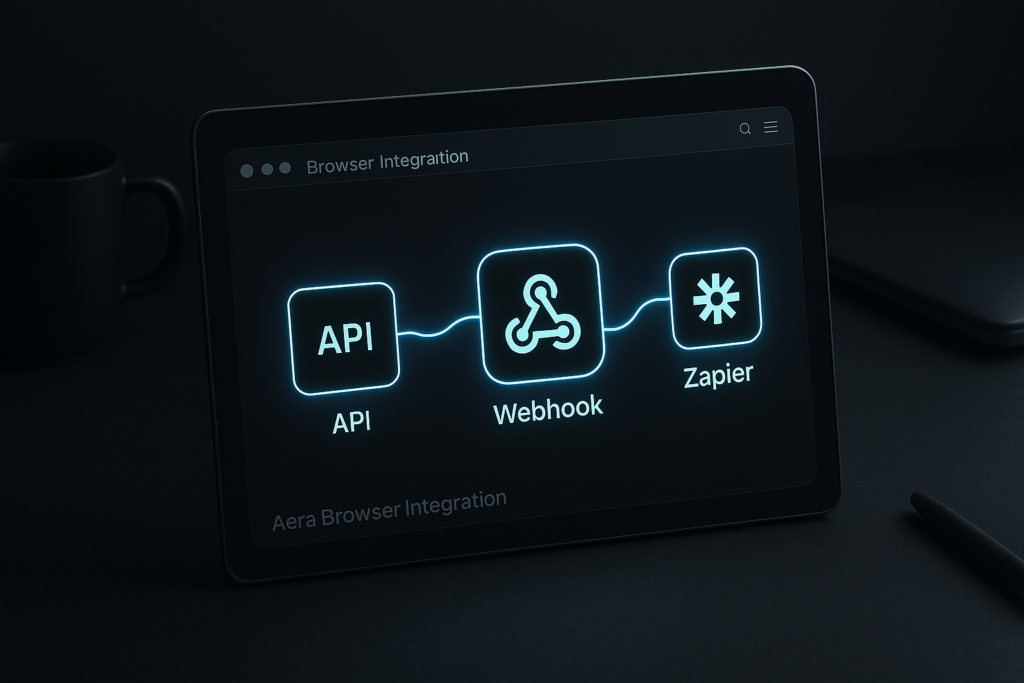Introduction
As automation continues to evolve, developers and businesses are increasingly turning to tools that seamlessly blend AI with workflow management. Aera Browser stands out as one of the most innovative AI browsers, allowing users to automate web interactions, integrate external services, and connect with popular platforms like Zapier.
In this guide, we’ll explore how Aera Browser integrates with your existing tech stack using APIs, webhooks, and third-party automation tools. Whether you’re running CI/CD pipelines, data workflows, or custom web automations, Aera is designed to fit right in.
Understanding Aera Browser’s Integration Capabilities
Aera Browser is not just another web browser, it’s a powerful automation engine. What makes it unique is its AI-driven interface and the ability to communicate directly with external systems through APIs and webhooks.
This means developers can use Aera to:
- Trigger automated workflows from within the browser.
- Send structured data from web pages to other applications.
- Connect Aera’s automation logic to services like Zapier, Slack, or Notion.
The result is a flexible, programmable environment that can easily become part of your larger automation ecosystem.
Using the Aera Browser API
The Aera Browser API enables developers to control browser sessions, extract structured data, and automate navigation using JSON-RPC calls.
Example API workflow:
- Navigate to a URL – Send a command to Aera’s API to visit a specific page.
- Analyze the page – Aera identifies actionable elements such as buttons, inputs, or links.
- Take action – You can instruct Aera to click, fill forms, or gather data.
- Return structured output – The browser sends a clean, machine-readable response to your system.
By connecting this API to your backend, you can integrate web automation directly into your CI/CD or data processing pipelines.
Connecting Aera Browser with Zapier
For non-developers or teams that rely on no-code workflows, Zapier integration is a game-changer.
Using Zapier, Aera Browser can interact with thousands of other tools without writing any code. For example, you can:
- Trigger a Zap when Aera completes a web automation task.
- Send collected data directly from Aera to Google Sheets, Airtable, or Notion.
- Automate repetitive browser tasks and push results to Slack or Discord for review.
This setup allows marketing teams, operations managers, and developers alike to turn web automation into a plug-and-play experience.
Leveraging Webhooks for Real-Time Automation
Webhooks play a crucial role in connecting Aera Browser to your broader automation ecosystem. They act as bridges between Aera and other systems, enabling real-time data exchange.
For example, you can configure a webhook that triggers whenever Aera completes a task—sending live updates to your application, triggering a build process, or updating a project dashboard.
This makes Aera particularly powerful in data-driven environments where immediate feedback and action are key.
Integrating Aera with CI/CD Pipelines
For engineering teams, Aera Browser can be integrated directly into continuous integration and delivery (CI/CD) workflows. This setup enables automated testing of front-end interactions, form submissions, or dynamic content.
Possible use cases include:
- UI testing: Run automated tests on web interfaces.
- Data validation: Verify web content or API responses during deployment.
- Automated deployments: Combine Aera with webhooks to trigger builds or rollbacks based on web app states.
By integrating Aera with tools like Jenkins, GitHub Actions, or CircleCI, teams can add browser-level intelligence to their deployment cycles.
Why Integration Matters
Integrating Aera Browser with your tech stack ensures:
- Scalability: Automation workflows grow with your organization.
- Efficiency: Repetitive browser tasks become fully autonomous.
- Interoperability: Aera fits smoothly alongside modern tools like Zapier, APIs, and webhooks.
- AI-driven flexibility: Instead of hardcoding browser actions, Aera adapts dynamically to context.
This level of integration transforms Aera from a browser into a central automation hub for developers and enterprises.
Internal Link Suggestions (for Codeblib)
- The AI Browser War: Aera Browser vs Atlas Browser
- Aera Browser: The AI-Powered Revolution Changing How We Browse the Web
- Why the AI Browser Race Matters in 2025: Atlas vs Chrome vs Edge
Conclusion
Aera Browser represents the next evolution of browser-based automation. With its API support, webhook integration, and Zapier connectivity, it’s designed to integrate seamlessly into both low-code and enterprise-grade workflows.
Whether you’re automating data collection, managing deployments, or streamlining your marketing processes, Aera Browser offers a versatile, AI-powered foundation that adapts to your existing tech stack.
If your goal is to connect automation, intelligence, and the web, Aera Browser might be the bridge you’ve been waiting for.
